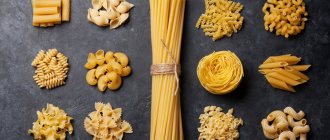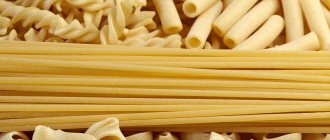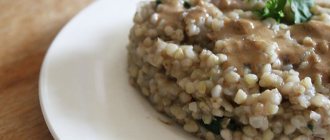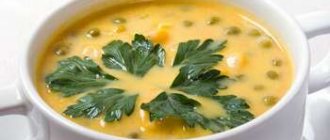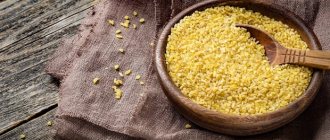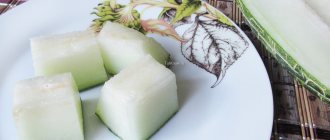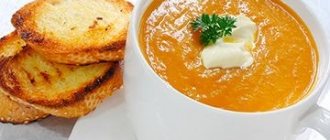Daily consumption rate of the product
The energy value of a 100-gram portion of the semi-finished product is approximately 7–9% of the daily requirement.
It all depends on what kind of diet a person follows. The standard daily intake for an adult is about 2000 kcal. You can eat pasta as much as you want, but taking into account the total calorie content of the daily diet, it is important to adhere to a balanced diet. For example, several plates of such products will really give you a feeling of fullness for the whole day, but the body will not receive all the necessary vitamins and microelements. From the point of view of nutritionists, the optimal portion for an adult is 150 g per day, and it is recommended to limit yourself to one meal per day.
It all depends on what kind of diet a person follows. The standard daily intake for an adult is about 2000 kcal. You can eat pasta as much as you want, but taking into account the total calorie content of the daily diet, it is important to adhere to a balanced diet. For example, several plates of such products will really give you a feeling of fullness for the whole day, but the body will not receive all the necessary vitamins and microelements. From the point of view of nutritionists, the optimal portion for an adult is 150 g per day, and it is recommended to limit yourself to one meal per day.
Properties of vermicelli
Nutritional value and composition | Vitamins | Minerals
How much does vermicelli cost (average price per 1 kg)?
Moscow and Moscow region.
95 rub.
According to most nutritionists, regular consumption of this product does not at all contribute to the appearance of excess weight, although the calorie content of noodles is quite high and amounts to 337 kcal per hundred grams of pasta. It contains practically no fat, and therefore you can only gain weight from the various sauces and gravies that are served with these products made from wheat flour.
It's no secret that vermicelli is a type of pasta that is distinguished by its shape (thin short sticks) and is prepared on the basis of unleavened dough. By the way, it is thanks to this shape that vermicelli gets its name, which is translated from Italian as worms.
Cooking vermicelli is not at all difficult: you need to pour it into boiling, pre-salted water and stir regularly to avoid burning. To prevent the vermicelli from sticking together during cooking, it is necessary that it floats freely in the pan. Basically, the cooking time for this product is always indicated on the packaging.
Ready noodles are most often served with vegetable dressings, olive oil, as well as tomato or cream sauces. In addition, vermicelli is used as an excellent side dish for meat, fish and poultry dishes, and is also often added to soups.
Ingredients of boiled pasta:
Vitamins:
| Vitamin: | IN 1 | AT 2 | AT 4 | AT 5 | AT 6 | AT 9 | RR | E |
| in mg. per 100 grams | 0.105 | 0.044 | 10.4 | 0.4 | 0.077 | 0.005 | 0.7 | 0.6 |
Minerals:
| Mineral: | Calcium | Phosphorus | Magnesium | Potassium |
| in mg. per 100 grams | 15 | 86 | 29 | 43 |
Delicious recipe! Why does beef steak turn out tough?
Products made from soft wheat contain very few healthy carbohydrates and fiber - practically nothing but empty calories. However, you shouldn’t blame flour for everything.
A 100-gram serving of any prepared pasta usually contains not 175 kcal, but much more. Where does the surplus come from? From all kinds of additives, gravies, sauces. We sometimes don’t take them into account, but the butter, cheese, and mayonnaise that we willingly flavor pasta with can turn out to be higher in calories than the main dish.
Vermicelli composition
It is worth noting that regardless of the varieties of this pasta, the composition of vermicelli remains unchanged: wheat flour, drinking water and table salt. A product based on flour from soft wheat varieties contains too much gluten, which is of practically no value to the body. Therefore, it is much healthier to eat noodles made from durum wheat, since it contains crystalline starch, which is not destroyed during the preparation of noodles, and also retains valuable proteins.
In addition, noodles made from durum wheat contain a sufficient amount of proteins, vitamins B, E, PP and H, amino acids, as well as such vital and sometimes irreplaceable elements as iron, magnesium, calcium, potassium and some others. All these substances make vermicelli a very useful food product to eat, but only if you choose exclusively pasta made from durum wheat flour and eat the finished dish in its pure form without rich and incredibly high-calorie sauces.
About pasta:
What calorie content boiled pasta has, what dietary properties it has, all this is of great interest to those who lead a healthy lifestyle and monitor their health and figure. So we will try to answer these questions in the next article.

What is pasta? These are products of various shapes, usually made from wheat flour. The dough is first kneaded in water and then dried in a special way. Sometimes rice or buckwheat flour is used, and other ingredients are added to the dough, for example, tomato paste, spinach, eggs. The key word here is flour. That is, the properties of pasta depend on the quality of the flour from which they are made. And we already know that there are different types of flour.
In accordance with domestic GOST, pasta is divided into three groups:
- group A – made from durum wheat flour of the highest, first and second grades;
- group B – made from soft glassy wheat flour of the highest and first grades;
- group B - made from premium and first grade wheat baking flour.
Durum wheat contains more gluten and less starch than soft wheat. Therefore, group A pasta has a lower glycemic index. In a number of countries, for example in Italy, it is allowed to produce pasta exclusively from durum wheat (and you can’t say that Italians are overweight).
Delicious recipe! Lamb with prunes and dried apricots
Proper pasta contains virtually no fat. According to Russian standards, 100 g of dry pasta should contain 10.4–12.3 g of protein, 1.1–2.1 g of fat, 64.5–71.5 g of carbohydrates, and their energy value is 327–351 kcal . Don't be scared by these numbers. In fact, the pasta is boiled, and the daily norm is on average 50–60 g of dry pasta (150–180 g of ready-made). Thus, we eat a fairly impressive portion, but get no more than 175 kcal.
Pasta made from durum varieties has the least calorie content. They are rich in healthy sugars that help maintain constant blood glucose levels. Thanks to this, we manage to increase the intervals between meals without suffering from attacks of hunger. Pasta contains B vitamins, which are necessary for brain function, as well as for the beauty of skin and hair. Let's not forget about fiber, which helps the digestive system process foods and get rid of everything unnecessary.
Pasta for weight loss:
And further:
How not to damage your figure:
- Choose pasta from group A (made from durum wheat). When in doubt, buy Italian-made products.
- Avoid instant noodles. Choose pasta varieties that cook for at least eight minutes.
- Cook them until they are slightly undercooked. In Russia, this option is not very common: it feels like the dish is half-baked. But in Italy it is considered standard to cook it just until al dente, when the middle of the pasta remains somewhat hard.
- Give preference to long products (spaghetti).
- Replace butter, mayonnaise, and cream sauce with light gravies. Bolognese, tomato with seafood, and vegetable sauces are suitable.
Delicious recipe! Is there any harm from sex?
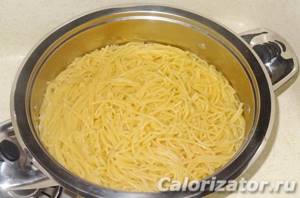
How to cook Vermicelli dish
- Place vermicelli in boiling salted water and stir.
- When the water boils again, reduce the heat and cover the pan with a lid.
- Cook vermicelli until tender, about 10 minutes.
- Vermicelli - 250 gr.
- Water - 500 gr.
- Salt (to taste) - 0.5 tsp.
Nutritional value of the Vermicelli dish (per 100 grams):
Calorie content Sea bass. Chemical composition and nutritional value.
The energy value of sea bass is 103 kcal.
Beneficial features
The value of red perch for the human body is due to its rich chemical composition. List of useful properties:
- lowers the level of “bad” cholesterol, which protects against the development of atherosclerosis;
- prevents hypoxia;
- controls blood sugar;
- has a positive effect on the thyroid gland;
- serves as a prevention of diseases of the cardiovascular, nervous and digestive systems;
- enhances metabolism and cleanses of waste and toxins, which promotes weight loss;
- reduces blood pressure;
- improves hematopoiesis;
- normalizes vision.
Perch
In Latin, the name of this family of fish is Perca.
This inhabitant of lakes, rivers and seas belongs to the predators, but is actually an omnivore. This fish is not so difficult to catch, but fishermen still consider it a worthy trophy (especially if a large specimen is caught). The meat of this fish is quite tasty and belongs to dietary products, and delicious dishes from it are found in the national cuisine of the Finns and Italians. All this is about perch. In Latin, the name of this family of fish is Perca. This inhabitant of lakes, rivers and seas belongs to the predators, but is actually an omnivore. This fish is not so difficult to catch, but fishermen still consider it a worthy trophy (especially if a large specimen is caught). The meat of this fish is quite tasty and belongs to dietary products, and delicious dishes from it are found in the national cuisine of the Finns and Italians. All this is about perch.
How many calories are in boiled pasta?
Naturally, the calorie content of boiled pasta depends on the type and method of preparation.
Pay attention to this table:
Table of calorie content of boiled pasta and nutritional value (BJU) per 100 grams:
| Boiled pasta: | Bel, gr. | Fat, gr. | Angle, gr. | Cal, kcal. |
| From durum wheat | 3.6 | 0.7 | 21.4 | 120 |
| Top grade | 3.5 | 0.4 | 23.2 | 112 |
| 1 grade | 3.6 | 0.4 | 2.0 | 112 |
| With milk | 10.0 | 5.0 | 37.0 | 227 |
| Egg | 4.7 | 0.9 | 29.0 | 143 |
| With cheese | 12.5 | 14.5 | 40.5 | 342 |
| With butter | 4.0 | 3.7 | 26.0 | 161 |
| With vegetable oil | 4.6 | 3.9 | 24.5 | 151 |
Sea bass: description, calorie content, nutritional supplements, benefits and harm
Sea bass is considered one of the most delicious sea fish. Belongs to the Scorpion family. There are about 100 species of perch. It lives in the waters of the Atlantic and Pacific Oceans. It is listed in the Red Book, which is due to the gradual extinction of the population. In Japan, perch meat is used in traditional dishes. In Russia, it is consumed salted and smoked, as well as steamed and fried. Fish is valued not only for its taste and low bone content, but also for its benefits to the body.
WEIGHT LOSS STORIES OF STARS!
Irina Pegova shocked everyone with her weight loss recipe: “I lost 27 kg and continue to lose weight, I just brew it at night. ” Read more >>
- 1. Description of the fish
- 2. Composition
- 3. Benefit
- 4. How to choose correctly
- 5. Recipes 5.1. Mebaru baked in the oven
- 5.2. Albanian style perch
- 5.3. In cheese sauce
- 5.4. With garlic and herbs
- 5.5. With hot pepper and ginger
- 5.6. Fish soup
- 5.7. Diet perch
- 5.8. Fried perch in batter
- 5.9. Hot smoked recipe

Sea bass is also called mebaru because of its large, bulging eyes. Depending on the species, the size of the fish varies from 20 cm to one meter with a weight of 10 kg. Outwardly it looks like a river perch, but the sea perch is predominantly red or pink in color. Particularly dangerous are the fins, sharp as peaks, containing nerve poison. With a strong injection, it can even cause severe inflammation with long wound healing. Therefore, you should clean the fish with extreme caution.
Sea bass is a long-lived fish, living up to 15 years.
This deep-sea predator reproduces in an unusual way: it does not spawn, but releases full-fledged fry in large numbers. Lives in cold waters at great depths. Therefore, during the catch, you have to use special devices (trawls), which destroy underwater coral reefs. This significantly worsens the ecological environment of the seas and oceans. The largest representatives are found in the basins of Northern Norway.
Fish meat is valued for its nutritional value and rich biochemical composition. Each variety has a different BJU content. On average, the calorie content per 100 grams of fresh product is about 105 kcal, smoked – 80–85 kcal, boiled – 113 kcal. Fried has the most calories – about 140 kcal. Energy value: proteins – 17.8 g, fats – 3.5 g, carbohydrates – 0.2 g.
The composition of the perch includes:
- macro- and microelements (magnesium, phosphorus, sulfur, potassium, chlorine, iron, iodine, calcium);
- vitamins of group B, PP, A, E, D;
- ascorbic acid;
- Omega-3 polyunsaturated fatty acids;
- light protein;
- taurine
It is useful to include perch meat in the regular diet of people watching their figure and suffering from excess cholesterol in the blood. Eating sea fish will prevent atherosclerosis. Due to its rejuvenating effect, perch meat is especially useful for women.
